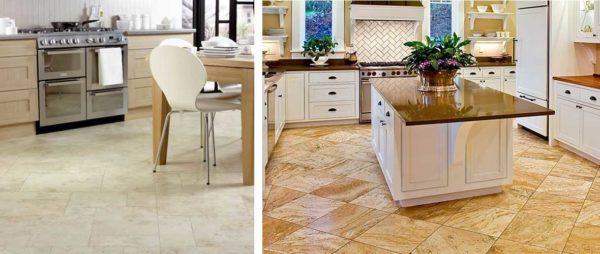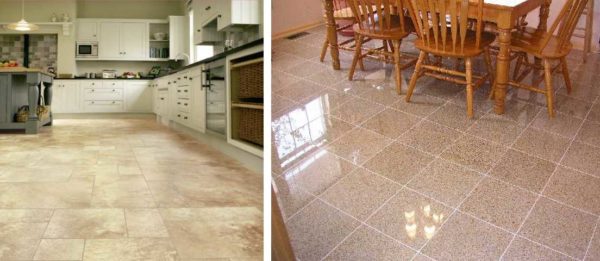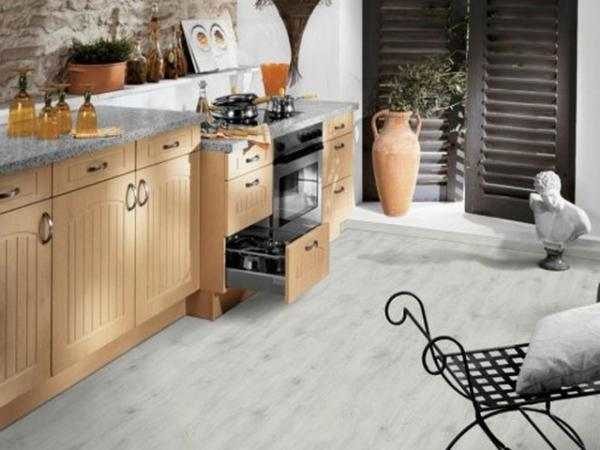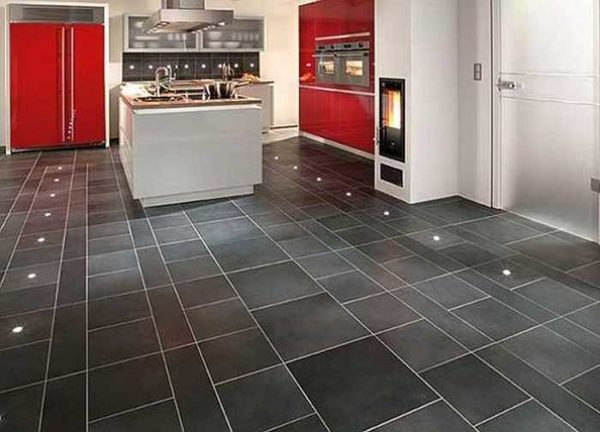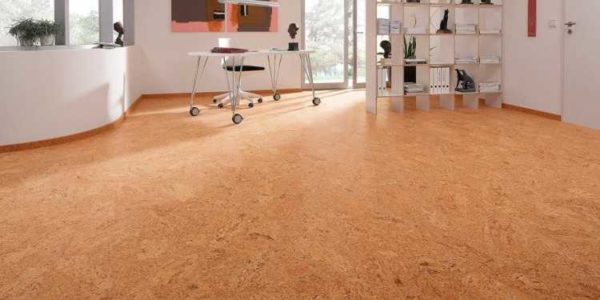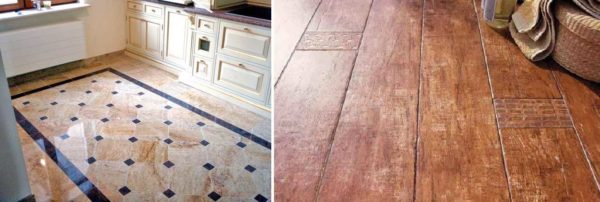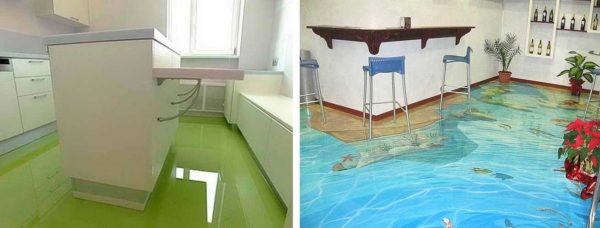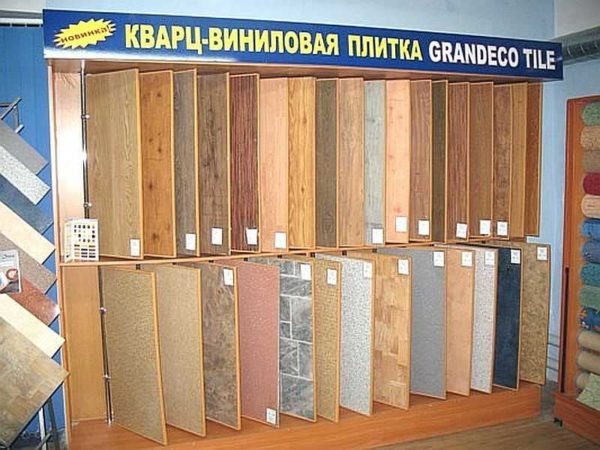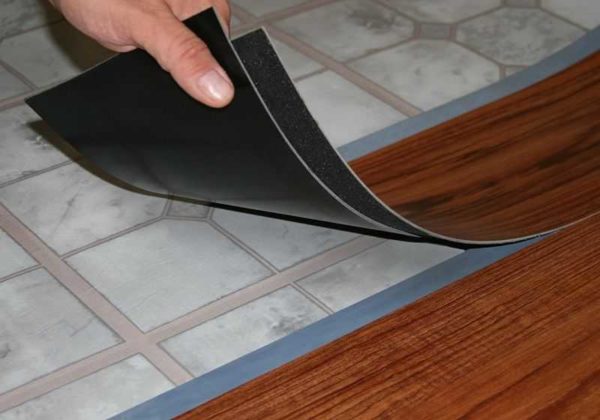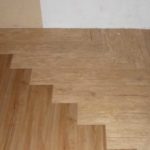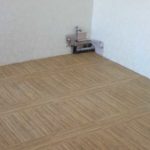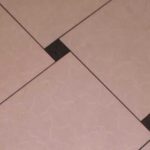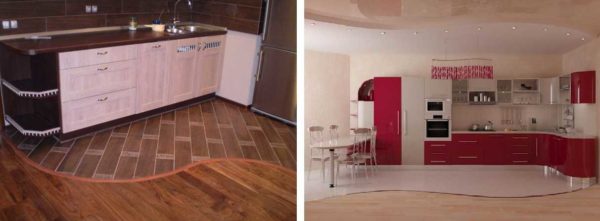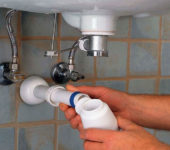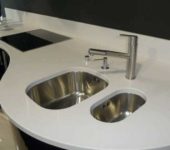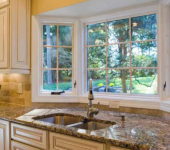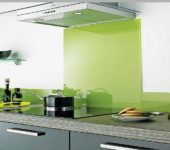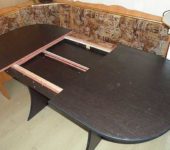Kitchen floor covering
One of the important tasks when planning a renovation is choosing a floor covering for your kitchen. This is important not only from an aesthetic point of view, but also from a technical point of view. After all, it is necessary to properly prepare the base for the coating, and they do this long before finishing. So what kind of flooring is best done in the kitchen must be decided in advance.
The content of the article
Most popular options
When talking about flooring for the kitchen, the first to emerge are two materials - ceramic tiles and linoleum. They are chosen in most cases. Although these materials are popular, they are not without flaws.
Kitchen floor tiles
In terms of practicality, wet room ceramic floor tiles are the best choice. It does not absorb any substances. Water, oil, any other liquid will remain on the surface until you remove them. Where the liquid can absorb is in the seams. And to prevent this from happening, choose a moisture-resistant grout and fill the joints well. In terms of practicality and ease of maintenance, this kitchen flooring is among the first.
The advantages of this type of material include a huge assortment. You can find any size, shape, color, with or without pictures. The choice is really big.
These were the pluses. Now about the cons:
- Feels like a "cold" kitchen tile flooring. To make your legs comfortable, you can put electric underfloor heating (and in the house you can make and water floor heating).
- If breakable dishes fall, they will break in 100% of cases. Moreover, the fragments fly in different directions and then they have to be collected for a long time.
- Falling on the tiles is very painful.
- Some species are very slippery even when dry. Those with a rough, embossed surface are much better in this regard - you can't slide on them. But dirt gets clogged into the "relief" and you have to wash it out with a stiff brush, making considerable efforts.
- After some time - 3-5 years - scuffs begin to appear in places of active movement (stove-table-refrigerator). Almost invisible at first, then more and more visible. And on expensive collections, these scuffs also appear, maybe a little later. There are, of course, options that are not slippery and not rubbing, but they do not look inspiring.
- The high cost of laying floor tiles. On average - $ 15 per square.
As you can see, there are plenty of cons too. There is one more consideration - on what base the tiles will be laid. If the floor is concrete, everything is simple. If necessary, it is leveled with a rough screed then you can lay tiles. If the floor is wooden, it is best to disassemble it and make a screed according to all the rules, and therefore already lay the tiles on the finished floor. As a result, the total cost of floor repairs will be considerable.
Linoleum in the kitchen
The second most popular kitchen flooring is linoleum. By tradition, let's start with the pros. If you take a whole piece of linoleum, then in terms of resistance to water, this type of coating is not inferior to ceramic tiles. At the same time, installation will take only a few hours, not days. You can lay linoleum on the floor yourself, but even if you have to hire a master, this type of work is estimated at an average of $ 4-5 per square meter.
If we talk about the assortment, then it is not less than that of ceramic tiles.There are different options - from plain-colored, to imitation of a wooden floor, laminate or parquet, the same tiles, mosaics, etc. True, in order for linoleum to serve in the kitchen for a long time, it is necessary to take a commercial or semi-commercial class, without a substrate. It is more durable, has a hard top layer. In a house or apartment, it is almost eternal. But such material costs a lot: $ 25-35 per square meter is a completely normal price. So the price is about the same as laying tiles.
The pluses of linoleum in the kitchen can also be attributed to a more comfortable atmosphere, as well as the fact that it is not so hard and, if dropped, some things have a chance to "survive". It washes no worse than tiles, even easier - streaks are usually not visible. In general, not a bad option.
Moving on to the cons:
- You will have to pay a lot of money for a wear-resistant coating.
- The material is not environmentally friendly, although there is natural linoleum - marmoleum. For the price it is not lower than the commercial one, but the service life is much shorter.
Like minuses and not many, but significant. We must also remember that lay linoleum must be on a level ground. It doesn't matter which one. The main thing is equal, whole, pure. If the floor is concrete, you can put it on it, but, again, it should be flat. It is possible on a wooden floor, but if the boards are uneven, it is better to lay a suitable sheet material on them - plywood, fiberboard, OSB, GVL. Choose for yourself. Linoleum is placed on top of a flat base, often gluing it over the entire surface. This kitchen flooring will be warm and durable.
What else can a kitchen flooring be?
This section focuses on less common materials and methods. Partly these are new materials, partly they are not very popular because of their high cost or not the most suitable characteristics.
Laminate
Laminate is a popular flooring material. It perfectly imitates a wooden surface, creating an atmosphere of comfort and tranquility. There are different color solutions - from almost white to almost black. There are even colored options - painted wood. In general, from the point of view of aesthetics, everything is fine. It also feels good - the legs are comfortable and warm, the laminate floor is washed remarkably, it absorbs shocks well, because the dropped dishes break less often.
But from the point of view of practicality - laying laminate in the kitchen is not a brilliant idea. Yes, there are moisture resistant types. But moisture resistance is about the surface, and the side edges remain the same material - pressed paper. If the puddle on the floor is not removed for a long time (everyone is at work) - several hours - then the moisture-resistant laminate swells, and after drying it remains warped.
It is also worth noting the high cost of moisture-resistant laminate (33 classes) - from $ 10 to $ 40 per square meter. The work is estimated at $ 3-6 per square - from the complexity of the installation scheme and the qualifications of the master. This is probably why this type of flooring is not very popular for kitchens.
How to lay a laminate with your own hands read here.
Cork covering
Cork flooring in the kitchen is used even less often than laminate. But this is not to blame for the characteristics of the material, but for its price - an expensive pleasure. The coating itself costs from $ 15 to $ 50 per square meter, installation services - from $ 7 per square meter. This is provided that the base is perfectly flat and clean.
The floor plug is available with or without backing. It is better to take it to the kitchen without a substrate. The substrate is the same as on the laminate - MDF, but it does not react well to water (swells). When using a glue plug, it is glued to the floor with special glue, covered with 2-3 layers of varnish on top, which creates a waterproof film. With this installation, even a flood is not terrible.
Cork kitchen flooring - looks very stylish, creates a cozy feeling, easy to clean (due to the applied varnish). But if the water remains for a long time, the varnish turns white. It is possible to return transparency to it, but it takes a long time to mess around. In general, it is beautiful, expensive and cozy.
Porcelain stoneware
Porcelain stoneware kitchen flooring is durable and beautiful. This material is mass-colored, very dense and tough. So scuffs, even if they are formed, are not visible. The material has the same advantages and disadvantages as ceramic tiles, only the material itself is more expensive (from $ 10 per square meter) and installation work - also from $ 10-12 per square meter.
Why is it rarely used? First, it’s an expensive pleasure. Secondly, the feet are cold, and heating is ineffective - the plates are thick, the thermal conductivity is low. And thirdly, it looks beautiful, but in large areas.
Self-leveling floors or liquid linoleum
This technology appeared relatively recently, therefore not many people know about this possibility. First of all, self-leveling floors are useful when leveling the base. This solution has the property of self-leveling - it is distributed over the surface, and it is leveled by itself, forming a perfectly flat surface. On this base, you can put any other floor covering you choose for the kitchen, or you can finish it using the same technology - use a polymer bulk floor or acrylic with the ability to make it with a 3D effect. This technology is also called "liquid linoleum", although this is not the same thing.
Polymer self-leveling floor - plain, matte or glossy, with varying degrees of gloss. The surface can be flat and smooth, or it can be rough. Acrylic is a transparent polymer, under which a film with a pattern is laid on a prepared base. This drawing is filled with liquid acrylic, due to which a three-dimensional image is obtained.
It is difficult to say in general at the cost of a self-leveling floor. It all depends on the amount of preparatory work. Remember to level the base first. Moreover, it is desirable with a leveler, and then with the finishing composition of the self-leveling floor so that the deviation is no more than 1 mm per square. Only application of the polymer composition without preparation costs from $ 5 per square meter. If this is an option with a 3D drawing - from $ 15. All preparatory work is assessed separately. In general, the idea is not cheap, but the result is excellent both externally and in terms of performance.
Vinyl tiles
This material is new. Called vinyl or PVC tiles, design tiles, or LVT (LVT) from the English name luxury vinyl tile. To put it simply, it is vinyl linoleum cut into pieces. The geometry can be different - squares, rectangles, complex shapes. Can fit on the same schemes like laminate or parquet, you can come up with unique combinations, since there are more colors, as well as geometric shapes.
Vinyl tiles differ from their predecessor - linoleum - by the form of release (cut into pieces) and by the method of installation. There are pure vinyl, there is with the addition of quartz sand. Such a material is called quartz-vinyl tiles (sometimes it is written together - quartz-vinyl coating). Quartz vinyl is denser, more durable. Scope - areas with high traffic (commercial premises with high traffic). This material will serve for a long time at home. If you do not need such durability (you like to change designs often), choose from pure PVC (32-42 grade is suitable for the kitchen).
Laying and types of tiles
According to the requirements for the base, vinyl tiles make more stringent requirements. It should be flat and tough. Suitable for concrete, cement floor, cement-bonded concrete screed or self-leveling, plywood, OSB, Chipboard... Such tiles cannot be laid on a soft porous base (old linoleum). Moreover, this base should have a difference of no more than 2 mm per 2 meters of area with two extremum points (the lowest and highest points).
There are several different types of PVC tiles and several different installation methods:
- A tile that is glued to special glue (it is indicated in the instructions which one is desirable to use).
- Self-adhesive. On the back there is an adhesive composition protected with paper. Before installation, it is removed, pressed to the base. She tile to the other is joined butt. the geometry is good, there are no problems on an even basis.
- With adhesive locks. In this case, the tile itself does not stick to the base. The coating turns out to be floating, incoherent and practically monolithic, since the locks are wide - several centimeters, covered with an adhesive composition.
- With mechanical locks. This type of vinyl tile also does not stick to the base, the fragments are connected to each other according to the thorn-groove principle.
What compares favorably with this material from linoleum and laminate - ease of installation. With any method of installation, do-it-yourself installation - no problem, with little time. The most important thing is to choose the drawing you want to create. It is cut with an ordinary clerical knife. Around the perimeter of the room, you need to leave a gap to compensate for thermal expansion (which one is indicated on the package, since different materials can be used).
Pros and cons
If we talk about the price, then it is comparable to commercial linoleum, while it has an even longer service life, it is easier to fit and wash (even models with a relief). It looks very much like parquet or laminate, maybe tiles, porcelain stoneware, marble, etc. It feels like a laminate underfoot - warm, but not so echoing (does not "clatter" when walking).
- May look like parquet
- Another version of the "parquet" layout of vinyl tiles
- It looks like ceramic tiles or porcelain stoneware
The surface is hard, not pressed through either by heels or furniture (including furniture on wheels). This is all - according to the reviews of those already operating. From all this, we can conclude that this flooring for the kitchen is an excellent choice and its only drawback is the high price, but it is compensated by the long service life.
Combined floor in the kitchen
Although laminate flooring in the kitchen is not the best choice, many people like it for aesthetic reasons, as well as ceramic tiles for ease of maintenance. There is a way - to use these two materials in the same room, but in different areas. Our kitchens are mainly divided into two parts - a work area, which contains cabinets, a stove, etc. and a dining room with table and chairs.
Tile or porcelain stoneware is laid in the working area, laminate in the table area (you can lay a cork). The junction of the two materials is decorated with a metal or plastic strip to match the coating or with a bright contrast.

